N-BK7 High Precision Windows
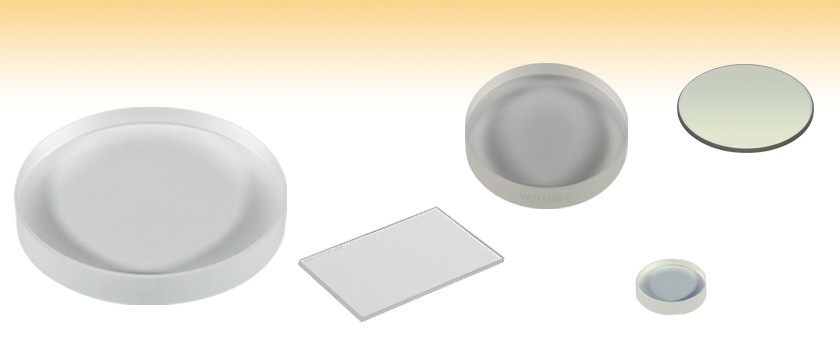
- Uncoated and AR-Coated Versions Available
- Laser Quality Polished Surfaces
- N-BK7 Optical Glass
WG12012
(Ø2")
WG11010-C
(Ø1")
WG11010R-AB
(25 mm x 36 mm)
WG10530-B
(Ø1/2")
WG11508-A
(Ø1.5")

Please Wait
| Flat Window Selection Guide | |
|---|---|
| Wavelength Range | Substrate Material |
| 180 nm - 8.0 μm | Calcium Fluoride (CaF2) |
| 185 nm - 2.1 μm | UV Fused Silica |
| 200 nm - 5.0 μm | Sapphire |
| 200 nm - 6.0 μm | Magnesium Fluoride (MgF2) |
| 220 nm to >50 µm | CVD Diamond Windows |
| 230 nm - 1.1 µm | UV Fused Silica, Textured Antireflective Surface |
| 250 nm - 1.6 µm | UV Fused Silica, for 45° AOI |
| 250 nm - 26 µm | Potassium Bromide (KBr) |
| 300 nm - 3 µm | Infrasil® |
| 350 nm - 2.0 μm | N-BK7 |
| 600 nm - 16 µm | Zinc Selenide (ZnSe) |
| 1 - 1.7 µm | Infrasil®, Textured Antireflective Surface |
| 1.2 - 8.0 μm | Silicon (Si) |
| 1.9 - 16 μm | Germanium (Ge) |
| 2 - 5 μm | Barium Fluoride (BaF2) |
| V-Coated Laser Windows | |
Features
- Five Sizes Available
-
- Ø1/2": 3.0 mm Thick
- Ø1": 1.0 mm or 5.0 mm Thick
- 25 mm x 36 mm: 1.0 mm Thick
- Ø1.5": 8.0 mm Thick
- Ø2": 12.0 mm Thick
- Available Uncoated or with One of Four Broadband AR Coatings
-
- 350 - 700 nm (-A Coating Designation)
- 400 - 1100 nm (-AB Coating Designation)
- 650 - 1050 nm (-B Coating Designation)
- 1050 - 1700 nm (-C Coating Designation)
Thorlabs' N-BK7 High-Precision Windows are available in Ø1/2", Ø1", 25 mm x 36 mm, Ø1.5", and Ø2" sizes. They are available uncoated for the 350 nm - 2.0 μm range or with one of our four low-loss standard broadband antireflection (AR) coatings deposited on both surfaces: -A (350 - 700 nm), -AB (400 - 1100 nm), -B (650 - 1050 nm), or -C (1050 - 1700 nm). While uncoated windows have typical losses of about 4% per surface, the AR coatings reduce this to Ravg < 1.0%. These AR coatings provide good performance for angles of incidence (AOI) between 0° and 30°. For additional information on these coatings, please see the Graphs tab.
The Ø1" windows are available with a 1.0 mm or 5.0 mm thick substrate. The 1.0 mm thick windows are ideal for ultrafast applications or in situations where space is limited. We recommend mounting the thin windows in our LMR1 or LMR1/M Fixed Lens Mount and securing them with a SM1LTRR Stress-Free Retaining Ring.
N-BK7 provides excellent transmission in the visible and near infrared portions of the spectrum. It is typically chosen whenever the additional benefits of UV fused silica (i.e., good transmission further into the UV and a lower coefficient of thermal expansion) are not necessary.
Thorlabs offers High Precision Windows fabricated from various substrate materials for use in a large variety of laser and industrial applications. We also offer laser windows and wedged laser windows, which have wavelength-specific AR coatings centered around commonly used laser wavelengths, and Brewster windows, which are used to eliminate p-polarization reflectance.
All of these N-BK7 high precision windows can be ordered uncoated or with one of the following broadband AR coatings: 350 - 700 nm (designated as -A), 400 - 1100 nm (designated as -AB), 650 - 1050 nm (designated as -B), or 1050 - 1700 nm (designated as -C).
The -A, -B, and -C coatings have an average reflectance of less than 0.5% (per surface) across the specified wavelength ranges, while the -AB coating has an average reflectance of less than 1% (per surface) across the wavelength range. These AR coatings provide good performance for angles of incidence (AOI) between 0° and 30° (0.5 NA).
For optics intended to be used at larger incident angles, consider ordering a custom coating optimized for a 45° angle of incidence; this custom coating is recommended for use with incidence angles from 25° to 52°. Please contact Tech Support to request a quote for this or other custom optics.
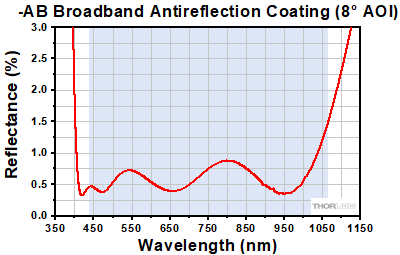
Click to Enlarge
Click for Raw Data
The blue shaded region indicates the specified 400 - 1100 nm wavelength range for optimum performance.
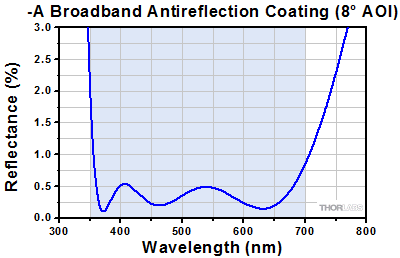
Click to Enlarge
Click for Raw Data
The blue shaded region indicates the specified 350 - 700 nm wavelength range for optimum performance.
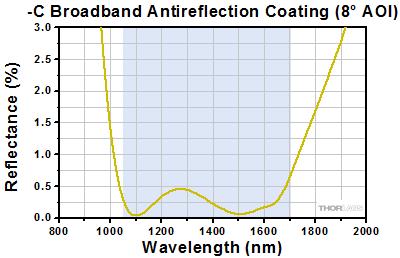
Click to Enlarge
Click for Raw Data
The blue shaded region indicates the specified 1050 - 1700 nm wavelength range for optimum performance.
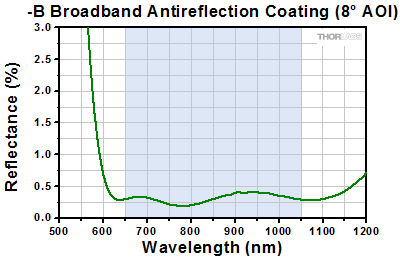
Click to Enlarge
Click for Raw Data
The blue shaded region indicates the specified 650 - 1050 nm wavelength range for optimum performance.
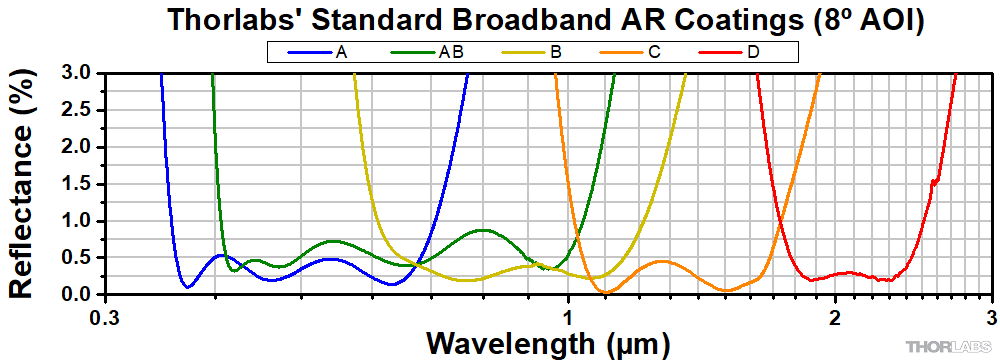
| Damage Threshold Specifications | |
|---|---|
| Coating Designation (Item # Suffix) |
Damage Threshold |
| -A | 7.5 J/cm2 at 532 nm, 10 ns, 10 Hz, Ø0.504 mm |
| -AB | 7.5 J/cm2 (532 nm, 10 ns, 10 Hz, Ø0.456 mm) 7.5 J/cm2 (1064 nm, 10 ns, 10 Hz, Ø0.407 mm) |
| -B | 7.5 J/cm2 at 810 nm, 10 ns, 10 Hz, Ø0.144 mm |
| -C | 7.5 J/cm2 at 1542 nm, 10 ns, 10 Hz, Ø0.123 mm |
Damage Threshold Data for Thorlabs' AR-Coated N-BK7 Windows
The specifications to the right are measured data for Thorlabs' N-BK7 high precision windows. Damage threshold specifications are constant for a given coating type, regardless of the size of the window.
Laser Induced Damage Threshold Tutorial
The following is a general overview of how laser induced damage thresholds are measured and how the values may be utilized in determining the appropriateness of an optic for a given application. When choosing optics, it is important to understand the Laser Induced Damage Threshold (LIDT) of the optics being used. The LIDT for an optic greatly depends on the type of laser you are using. Continuous wave (CW) lasers typically cause damage from thermal effects (absorption either in the coating or in the substrate). Pulsed lasers, on the other hand, often strip electrons from the lattice structure of an optic before causing thermal damage. Note that the guideline presented here assumes room temperature operation and optics in new condition (i.e., within scratch-dig spec, surface free of contamination, etc.). Because dust or other particles on the surface of an optic can cause damage at lower thresholds, we recommend keeping surfaces clean and free of debris. For more information on cleaning optics, please see our Optics Cleaning tutorial.
Testing Method
Thorlabs' LIDT testing is done in compliance with ISO/DIS 11254 and ISO 21254 specifications.
First, a low-power/energy beam is directed to the optic under test. The optic is exposed in 10 locations to this laser beam for 30 seconds (CW) or for a number of pulses (pulse repetition frequency specified). After exposure, the optic is examined by a microscope (~100X magnification) for any visible damage. The number of locations that are damaged at a particular power/energy level is recorded. Next, the power/energy is either increased or decreased and the optic is exposed at 10 new locations. This process is repeated until damage is observed. The damage threshold is then assigned to be the highest power/energy that the optic can withstand without causing damage. A histogram such as that below represents the testing of one BB1-E02 mirror.

The photograph above is a protected aluminum-coated mirror after LIDT testing. In this particular test, it handled 0.43 J/cm2 (1064 nm, 10 ns pulse, 10 Hz, Ø1.000 mm) before damage.

| Example Test Data | |||
|---|---|---|---|
| Fluence | # of Tested Locations | Locations with Damage | Locations Without Damage |
| 1.50 J/cm2 | 10 | 0 | 10 |
| 1.75 J/cm2 | 10 | 0 | 10 |
| 2.00 J/cm2 | 10 | 0 | 10 |
| 2.25 J/cm2 | 10 | 1 | 9 |
| 3.00 J/cm2 | 10 | 1 | 9 |
| 5.00 J/cm2 | 10 | 9 | 1 |
According to the test, the damage threshold of the mirror was 2.00 J/cm2 (532 nm, 10 ns pulse, 10 Hz, Ø0.803 mm). Please keep in mind that these tests are performed on clean optics, as dirt and contamination can significantly lower the damage threshold of a component. While the test results are only representative of one coating run, Thorlabs specifies damage threshold values that account for coating variances.
Continuous Wave and Long-Pulse Lasers
When an optic is damaged by a continuous wave (CW) laser, it is usually due to the melting of the surface as a result of absorbing the laser's energy or damage to the optical coating (antireflection) [1]. Pulsed lasers with pulse lengths longer than 1 µs can be treated as CW lasers for LIDT discussions.
When pulse lengths are between 1 ns and 1 µs, laser-induced damage can occur either because of absorption or a dielectric breakdown (therefore, a user must check both CW and pulsed LIDT). Absorption is either due to an intrinsic property of the optic or due to surface irregularities; thus LIDT values are only valid for optics meeting or exceeding the surface quality specifications given by a manufacturer. While many optics can handle high power CW lasers, cemented (e.g., achromatic doublets) or highly absorptive (e.g., ND filters) optics tend to have lower CW damage thresholds. These lower thresholds are due to absorption or scattering in the cement or metal coating.

LIDT in linear power density vs. pulse length and spot size. For long pulses to CW, linear power density becomes a constant with spot size. This graph was obtained from [1].

Pulsed lasers with high pulse repetition frequencies (PRF) may behave similarly to CW beams. Unfortunately, this is highly dependent on factors such as absorption and thermal diffusivity, so there is no reliable method for determining when a high PRF laser will damage an optic due to thermal effects. For beams with a high PRF both the average and peak powers must be compared to the equivalent CW power. Additionally, for highly transparent materials, there is little to no drop in the LIDT with increasing PRF.
In order to use the specified CW damage threshold of an optic, it is necessary to know the following:
- Wavelength of your laser
- Beam diameter of your beam (1/e2)
- Approximate intensity profile of your beam (e.g., Gaussian)
- Linear power density of your beam (total power divided by 1/e2 beam diameter)
Thorlabs expresses LIDT for CW lasers as a linear power density measured in W/cm. In this regime, the LIDT given as a linear power density can be applied to any beam diameter; one does not need to compute an adjusted LIDT to adjust for changes in spot size, as demonstrated by the graph to the right. Average linear power density can be calculated using the equation below.

The calculation above assumes a uniform beam intensity profile. You must now consider hotspots in the beam or other non-uniform intensity profiles and roughly calculate a maximum power density. For reference, a Gaussian beam typically has a maximum power density that is twice that of the uniform beam (see lower right).
Now compare the maximum power density to that which is specified as the LIDT for the optic. If the optic was tested at a wavelength other than your operating wavelength, the damage threshold must be scaled appropriately. A good rule of thumb is that the damage threshold has a linear relationship with wavelength such that as you move to shorter wavelengths, the damage threshold decreases (i.e., a LIDT of 10 W/cm at 1310 nm scales to 5 W/cm at 655 nm):

While this rule of thumb provides a general trend, it is not a quantitative analysis of LIDT vs wavelength. In CW applications, for instance, damage scales more strongly with absorption in the coating and substrate, which does not necessarily scale well with wavelength. While the above procedure provides a good rule of thumb for LIDT values, please contact Tech Support if your wavelength is different from the specified LIDT wavelength. If your power density is less than the adjusted LIDT of the optic, then the optic should work for your application.
Please note that we have a buffer built in between the specified damage thresholds online and the tests which we have done, which accommodates variation between batches. Upon request, we can provide individual test information and a testing certificate. The damage analysis will be carried out on a similar optic (customer's optic will not be damaged). Testing may result in additional costs or lead times. Contact Tech Support for more information.
Pulsed Lasers
As previously stated, pulsed lasers typically induce a different type of damage to the optic than CW lasers. Pulsed lasers often do not heat the optic enough to damage it; instead, pulsed lasers produce strong electric fields capable of inducing dielectric breakdown in the material. Unfortunately, it can be very difficult to compare the LIDT specification of an optic to your laser. There are multiple regimes in which a pulsed laser can damage an optic and this is based on the laser's pulse length. The highlighted columns in the table below outline the relevant pulse lengths for our specified LIDT values.
Pulses shorter than 10-9 s cannot be compared to our specified LIDT values with much reliability. In this ultra-short-pulse regime various mechanics, such as multiphoton-avalanche ionization, take over as the predominate damage mechanism [2]. In contrast, pulses between 10-7 s and 10-4 s may cause damage to an optic either because of dielectric breakdown or thermal effects. This means that both CW and pulsed damage thresholds must be compared to the laser beam to determine whether the optic is suitable for your application.
| Pulse Duration | t < 10-9 s | 10-9 < t < 10-7 s | 10-7 < t < 10-4 s | t > 10-4 s |
|---|---|---|---|---|
| Damage Mechanism | Avalanche Ionization | Dielectric Breakdown | Dielectric Breakdown or Thermal | Thermal |
| Relevant Damage Specification | No Comparison (See Above) | Pulsed | Pulsed and CW | CW |
When comparing an LIDT specified for a pulsed laser to your laser, it is essential to know the following:

LIDT in energy density vs. pulse length and spot size. For short pulses, energy density becomes a constant with spot size. This graph was obtained from [1].
- Wavelength of your laser
- Energy density of your beam (total energy divided by 1/e2 area)
- Pulse length of your laser
- Pulse repetition frequency (prf) of your laser
- Beam diameter of your laser (1/e2 )
- Approximate intensity profile of your beam (e.g., Gaussian)
The energy density of your beam should be calculated in terms of J/cm2. The graph to the right shows why expressing the LIDT as an energy density provides the best metric for short pulse sources. In this regime, the LIDT given as an energy density can be applied to any beam diameter; one does not need to compute an adjusted LIDT to adjust for changes in spot size. This calculation assumes a uniform beam intensity profile. You must now adjust this energy density to account for hotspots or other nonuniform intensity profiles and roughly calculate a maximum energy density. For reference a Gaussian beam typically has a maximum energy density that is twice that of the 1/e2 beam.
Now compare the maximum energy density to that which is specified as the LIDT for the optic. If the optic was tested at a wavelength other than your operating wavelength, the damage threshold must be scaled appropriately [3]. A good rule of thumb is that the damage threshold has an inverse square root relationship with wavelength such that as you move to shorter wavelengths, the damage threshold decreases (i.e., a LIDT of 1 J/cm2 at 1064 nm scales to 0.7 J/cm2 at 532 nm):

You now have a wavelength-adjusted energy density, which you will use in the following step.
Beam diameter is also important to know when comparing damage thresholds. While the LIDT, when expressed in units of J/cm², scales independently of spot size; large beam sizes are more likely to illuminate a larger number of defects which can lead to greater variances in the LIDT [4]. For data presented here, a <1 mm beam size was used to measure the LIDT. For beams sizes greater than 5 mm, the LIDT (J/cm2) will not scale independently of beam diameter due to the larger size beam exposing more defects.
The pulse length must now be compensated for. The longer the pulse duration, the more energy the optic can handle. For pulse widths between 1 - 100 ns, an approximation is as follows:

Use this formula to calculate the Adjusted LIDT for an optic based on your pulse length. If your maximum energy density is less than this adjusted LIDT maximum energy density, then the optic should be suitable for your application. Keep in mind that this calculation is only used for pulses between 10-9 s and 10-7 s. For pulses between 10-7 s and 10-4 s, the CW LIDT must also be checked before deeming the optic appropriate for your application.
Please note that we have a buffer built in between the specified damage thresholds online and the tests which we have done, which accommodates variation between batches. Upon request, we can provide individual test information and a testing certificate. Contact Tech Support for more information.
[1] R. M. Wood, Optics and Laser Tech. 29, 517 (1998).
[2] Roger M. Wood, Laser-Induced Damage of Optical Materials (Institute of Physics Publishing, Philadelphia, PA, 2003).
[3] C. W. Carr et al., Phys. Rev. Lett. 91, 127402 (2003).
[4] N. Bloembergen, Appl. Opt. 12, 661 (1973).
In order to illustrate the process of determining whether a given laser system will damage an optic, a number of example calculations of laser induced damage threshold are given below. For assistance with performing similar calculations, we provide a spreadsheet calculator that can be downloaded by clicking the button to the right. To use the calculator, enter the specified LIDT value of the optic under consideration and the relevant parameters of your laser system in the green boxes. The spreadsheet will then calculate a linear power density for CW and pulsed systems, as well as an energy density value for pulsed systems. These values are used to calculate adjusted, scaled LIDT values for the optics based on accepted scaling laws. This calculator assumes a Gaussian beam profile, so a correction factor must be introduced for other beam shapes (uniform, etc.). The LIDT scaling laws are determined from empirical relationships; their accuracy is not guaranteed. Remember that absorption by optics or coatings can significantly reduce LIDT in some spectral regions. These LIDT values are not valid for ultrashort pulses less than one nanosecond in duration.

A Gaussian beam profile has about twice the maximum intensity of a uniform beam profile.
CW Laser Example
Suppose that a CW laser system at 1319 nm produces a 0.5 W Gaussian beam that has a 1/e2 diameter of 10 mm. A naive calculation of the average linear power density of this beam would yield a value of 0.5 W/cm, given by the total power divided by the beam diameter:

However, the maximum power density of a Gaussian beam is about twice the maximum power density of a uniform beam, as shown in the graph to the right. Therefore, a more accurate determination of the maximum linear power density of the system is 1 W/cm.
An AC127-030-C achromatic doublet lens has a specified CW LIDT of 350 W/cm, as tested at 1550 nm. CW damage threshold values typically scale directly with the wavelength of the laser source, so this yields an adjusted LIDT value:

The adjusted LIDT value of 350 W/cm x (1319 nm / 1550 nm) = 298 W/cm is significantly higher than the calculated maximum linear power density of the laser system, so it would be safe to use this doublet lens for this application.
Pulsed Nanosecond Laser Example: Scaling for Different Pulse Durations
Suppose that a pulsed Nd:YAG laser system is frequency tripled to produce a 10 Hz output, consisting of 2 ns output pulses at 355 nm, each with 1 J of energy, in a Gaussian beam with a 1.9 cm beam diameter (1/e2). The average energy density of each pulse is found by dividing the pulse energy by the beam area:

As described above, the maximum energy density of a Gaussian beam is about twice the average energy density. So, the maximum energy density of this beam is ~0.7 J/cm2.
The energy density of the beam can be compared to the LIDT values of 1 J/cm2 and 3.5 J/cm2 for a BB1-E01 broadband dielectric mirror and an NB1-K08 Nd:YAG laser line mirror, respectively. Both of these LIDT values, while measured at 355 nm, were determined with a 10 ns pulsed laser at 10 Hz. Therefore, an adjustment must be applied for the shorter pulse duration of the system under consideration. As described on the previous tab, LIDT values in the nanosecond pulse regime scale with the square root of the laser pulse duration:

This adjustment factor results in LIDT values of 0.45 J/cm2 for the BB1-E01 broadband mirror and 1.6 J/cm2 for the Nd:YAG laser line mirror, which are to be compared with the 0.7 J/cm2 maximum energy density of the beam. While the broadband mirror would likely be damaged by the laser, the more specialized laser line mirror is appropriate for use with this system.
Pulsed Nanosecond Laser Example: Scaling for Different Wavelengths
Suppose that a pulsed laser system emits 10 ns pulses at 2.5 Hz, each with 100 mJ of energy at 1064 nm in a 16 mm diameter beam (1/e2) that must be attenuated with a neutral density filter. For a Gaussian output, these specifications result in a maximum energy density of 0.1 J/cm2. The damage threshold of an NDUV10A Ø25 mm, OD 1.0, reflective neutral density filter is 0.05 J/cm2 for 10 ns pulses at 355 nm, while the damage threshold of the similar NE10A absorptive filter is 10 J/cm2 for 10 ns pulses at 532 nm. As described on the previous tab, the LIDT value of an optic scales with the square root of the wavelength in the nanosecond pulse regime:

This scaling gives adjusted LIDT values of 0.08 J/cm2 for the reflective filter and 14 J/cm2 for the absorptive filter. In this case, the absorptive filter is the best choice in order to avoid optical damage.
Pulsed Microsecond Laser Example
Consider a laser system that produces 1 µs pulses, each containing 150 µJ of energy at a repetition rate of 50 kHz, resulting in a relatively high duty cycle of 5%. This system falls somewhere between the regimes of CW and pulsed laser induced damage, and could potentially damage an optic by mechanisms associated with either regime. As a result, both CW and pulsed LIDT values must be compared to the properties of the laser system to ensure safe operation.
If this relatively long-pulse laser emits a Gaussian 12.7 mm diameter beam (1/e2) at 980 nm, then the resulting output has a linear power density of 5.9 W/cm and an energy density of 1.2 x 10-4 J/cm2 per pulse. This can be compared to the LIDT values for a WPQ10E-980 polymer zero-order quarter-wave plate, which are 5 W/cm for CW radiation at 810 nm and 5 J/cm2 for a 10 ns pulse at 810 nm. As before, the CW LIDT of the optic scales linearly with the laser wavelength, resulting in an adjusted CW value of 6 W/cm at 980 nm. On the other hand, the pulsed LIDT scales with the square root of the laser wavelength and the square root of the pulse duration, resulting in an adjusted value of 55 J/cm2 for a 1 µs pulse at 980 nm. The pulsed LIDT of the optic is significantly greater than the energy density of the laser pulse, so individual pulses will not damage the wave plate. However, the large average linear power density of the laser system may cause thermal damage to the optic, much like a high-power CW beam.
| Posted Comments: | |
Hanjun Koh
(posted 2024-10-08 08:01:53.12) Is one-side AR coating possible for WG11010R-C? EGies
(posted 2024-10-09 12:02:35.0) Thank you for contacting Thorlabs. We may be able to provide this as a custom part. We have reached out to you directly to discuss your specific requirements. ChangYi Lin
(posted 2023-07-26 12:20:21.767) Hello, what is the Damage Threshold of the WG10530-B when facing on CW laser? Datasheet says "7.5 J/cm2 at 810 nm, 10 ns, 10 Hz, Ø0.144 mm". I would like to know how to calculate the CW Damage Threshold. Is "7.5 J/cm2 / 10ns = 750 MW/cm^2 "? Thanks! cdolbashian
(posted 2023-08-04 12:32:32.0) Thank you for reaching out to us with this inquiry. While we do not explicitly have CW damage threshold measurements for this substrate + coating combination, we can often validate the use of a specific laser with a specific window. I have reached out to you for your specific laser parameters. user
(posted 2023-04-17 08:43:55.19) I'm interested in the TWE of WG11050-C and how sensitive the reflectivity of the C coating to AOI in the ranges 0°-15°. Thanks in advance. cdolbashian
(posted 2023-04-26 10:12:16.0) Thank you for this inquiry. I have reached out to you directly with the requested information! Jong-goo Kang
(posted 2023-01-27 16:51:45.137) As refractive index, tansmittanse of BK7(uncoated) is 92.15 %. But 92.7% at your data sheet. I want to know that reason of different. Kai Kruse
(posted 2021-11-10 07:24:52.47) I am interested in the transmitted wavefront error instead of surface irregularity. Is the error on the 1/2" window comparable to the 1" window?
Thank you jgreschler
(posted 2021-11-12 04:57:16.0) Thank you for reaching out to Thorlabs. The transmitted wavefront error for the 1/2" windows will be the same as or better than that of the 1" windows. In this case we can guarantee lambda/4 performance. Yongqi Shi
(posted 2019-03-29 07:56:16.787) Hello, is it possible to order some customized-size windows with double sided type-B AR coating? The dimension we need is 104 mm (+/-0,2) x 114 mm (+/-0,2) and thickness would be 2mm around. YLohia
(posted 2019-04-01 10:20:46.0) Hello, thank you for contacting Thorlabs. Custom item inquiries can be made by clicking the red "Request Quote" button above. I will reach out to you directly to discuss the feasibility of offering this. felix.jaeckel
(posted 2017-04-24 12:56:34.42) Is it possible to get a pair of windows (e.g. WG10530-A) with closely matched thickness (e.g. +-5um)? This is for a white light interferometric application where path length in sample and reference beams need to be closely matched.
Thank you! tfrisch
(posted 2017-05-02 10:23:52.0) Hello, thank you for contacting Thorlabs. I will reach out to you directly to discuss your application and our capabilities. ankur.agrawal92
(posted 2017-03-24 16:38:20.953) Hi,
I would like to know the reflectivity of WG11010-B - Ø1" N-BK7 Broadband Precision Window, AR Coated: 650 - 1050 nm, t = 1 mm when the light is incident NORMALLY (AOI = 0 degrees) on it?
The ratio in the datasheet are measured at AOI of 8 degrees. jlow
(posted 2017-03-29 04:37:18.0) Response from Jeremy at Thorlabs: At 0°, the detector and the light source occupy the same beam path and therefore the measurement is not possible. With our current measurement system, the closest we can confidently measure is 8° AOI. The reflectivity at 8° is very similar to the reflectivity near 0° so you can use the data on the website as an estimate. cmar5964
(posted 2016-06-16 09:17:59.663) Hello,
could you provide information of the reflectivity of the WG11050-A for 45 degrees incidence? We want a pick-off only a very small fraction (order mW) from a 2.5 W beam at 626 nm, but we'd rather use an attenuator instead of getting expensive custom coatings. besembeson
(posted 2016-06-16 04:18:10.0) Response from Bweh at Thorlabs USA: I will contact you with the data. The standard coating should show similar reflectivity up to 30deg. We offer special coatings optimized for 45deg if you are interested in maintaining the reflectivity that we specify. jens.kiessling
(posted 2014-09-30 17:51:37.137) Dear Thorlabs Team,
I need 1" windows AR-coated for 900-1300 nm. Can you send me the transission data for the B coating up to 1300 nm? Is a custom coating possible?
thanks in advance
Jens besembeson
(posted 2014-10-09 12:41:51.0) Response from Bweh at Thorlabs: I will send you an email that shows the reflectivity of the -B coating up to 1400nm. This can also be found at the following link, under "AR Coating": https://www.thorlabs.de/newgrouppage9.cfm?objectgroup_id=5840. I will follow up by email about your application and if a custom coating (which we can do) will be needed. user
(posted 2014-09-23 08:20:38.853) Which component can be used to mount WG12012, cause it is 12mm thick? jlow
(posted 2014-09-25 09:32:48.0) Response from Jeremy at Thorlabs: We have fixed mount, kinematic mounts, lens tubes, translation mount, etc. that can be used with this. Since you did not provide an e-mail address, can you contact us at techsupport@thorlabs.com please? We can suggest the appropriate mount for your application. m.schnell
(posted 2014-05-23 16:04:58.233) Hi, do you have 1-inch windows with a thickness of only 1 mm or 3mm, similar to, for example, the economy beam splitter EBS1? Thanks! besembeson
(posted 2014-05-29 01:54:15.0) A response from Bweh E at Thorlabs Newton-USA: Thanks for contacting Thorlabs. We are actually working on releasing these 1mm windows, with and without AR coating. I will contact you via email to know which ones you are be interested in, and what quantity. acb20
(posted 2014-04-17 16:21:52.123) Is it possible to get the -C15 coating on these windows? That is the coating with low reflectivity at both ~532 nm and ~1064nm offered on your wedged beamsplitters. jlow
(posted 2014-04-17 04:33:36.0) Response from Jeremy at Thorlabs: Yes we can do this. I will contact you on getting this quoted. simonk
(posted 2014-02-18 11:31:40.387) What is the maximum (continuous) temperature which the AR coatings are able to withstand?
What is the maximum temperature gradient that can be applied (continuously) between the two faces of the 1/2" 3mm BK7 and fused silica windows? jlow
(posted 2014-02-27 05:18:56.0) Response from Jeremy at Thorlabs: The maximum temperature will be around 200°C or so. We do not spec a maximum temperature gradient since it can depend on the thermal boundary conditions and geometrical boundary conditions of the window. However, I would recommend UVFS over N-BK7 because of its much lower coefficient of thermal coefficient. edulgergil
(posted 2013-02-27 03:18:52.237) We want to use WG11050-B in EMI susceptible system, is there any information related to wide rf spectral response of this product? tcohen
(posted 2013-03-06 14:44:00.0) Response from Tim at Thorlabs: Thank you for your feedback. We have not explored testing this before, nor does there seem to be a wealth of information available on this. This will most likely need to be tested directly in your setup. I will contact you to discuss this further. user
(posted 2010-06-07 15:09:23.0) Response from Javier at Thorlabs to jenna.holder: We can provide our windows in many custom sizes. I will contact you with more details. jenna.holder
(posted 2010-06-07 08:51:43.0) I require a window of 5cm diameter. Do you have any of this size? jens
(posted 2009-06-10 14:59:08.0) An answer from Jens at Thorlabs: the thickness of the windows used in this measurement was 5mm. jeffrey.owen.white
(posted 2009-06-10 09:28:17.0) Under the materials tab in the windows page, theres a graph of transmission for BK7 and fused silica. One needs to know the sample thickness in order to interpret those graphs. Laurie
(posted 2009-02-02 08:38:56.0) Response from Laurie at Thorlabs to Alexander.Radnaev: Thank you for taking some time to provide us with feedback as to how we can improve our web presentations. We have updated updated our transmission graphs to include a note that surface reflections are included in these plots. We apologize for any confusion this may have caused and hope that these new graphs are more clear. Alexander.Radnaev
(posted 2009-01-31 16:20:06.0) Hello,
Id make a note on your BK7 transmission graph (http://63.161.211.69/BK7trans.jpg)
"Surface reflections included" as it is in your catalog. Otherwise its confusing.
Thanks, Tyler
(posted 2008-11-03 16:23:41.0) A response from Tyler at Thorlabs to dl1net: The focal point position will be retarded by the laser window. A member of our technical support department will contact you in the hopes of providing information specific to your application. Thank you for using our forum and if we can be of any further assistance please contact us again. dl1net
(posted 2008-10-31 14:54:27.0) Hello,
a very fundamental question:
I have a laser beam, which is focussed by a lens. Now, if i put a laser window in between the lens and the focus, how will the focus position and the focus beam waist change?
Many thanks for a fast answer!!
Johannes Hagen TechnicalMarketing
(posted 2008-06-03 15:20:25.0) Thank you for your interest in Thorlabs. We have updated our drawings to help clairfy that both sides of the lenses are coated. If you have any further questions please feel free to contact us directly. ghegenbart
(posted 2008-04-15 08:16:10.0) The AR coated versions are coated on both sides. However, in the pdf drawings there is a hint on the coating with an arrow pointing to only one surface of the item. This is misleading since it suggests that only one side is coated. TechnicalMarketing
(posted 2007-10-08 11:22:08.0) We added an AR Coatings tab so that you can see the theoretical performance of the AR coatings available from stock on our precision laser quality windows. Thank you for taking the time to inform us that this web page was missing the AR coating curves. acable
(posted 2007-10-05 20:17:59.0) AR coating curves are no where to be found, also table on Spec tab says "coating" without saying what kind of coating. |
| Window Selection Guide (Table Sorted by Wavelength) | |||||
|---|---|---|---|---|---|
| Substrate and Window Type | Wavelength Range | Available AR Coatings | Reflectance over AR Coating Rangea | Transmission Data | Reflectance Data |
| Calcium Fluoride (CaF2): Flat or Wedged |
180 nm - 8.0 μm | Uncoated | - | Raw Data |
- |
| -D Coating, 1.65 - 3.0 µm | Ravg < 1.0%; Rabs < 2.0% at 0° AOI | Raw Data |
Raw Data |
||
| UV Fused Silica: Flat, Wedged, V-Coated Flat, or V-Coated Wedged |
185 nm - 2.1 μm | Uncoated (Flat or Wedged) |
- | Raw Data |
- |
| -UV Coating, 245 - 400 nm (Flat or Wedged) |
Ravg < 0.5% at 0° AOI | - | Raw Data |
||
| -C3 Coating, 261 - 266 nm (V-Coated) |
Ravg < 0.5% at 0° AOI | - | Raw Data |
||
| -C6 Coating, 350 - 450 nm (V-Coated) |
Ravg < 0.5% at 0° AOI | - | Raw Data |
||
| -A Coating, 350 - 700 nm (Flat or Wedged) |
Ravg < 0.5% at 0° AOI | - | Raw Data |
||
| -B Coating, 650 - 1050 nm (Flat or Wedged) |
Ravg < 0.5% at 0° AOI | - | Raw Data |
||
| -C Coating, 1050 - 1700 nm (Flat or Wedged) |
Ravg < 0.5% at 0° AOI | - | Raw Data |
||
| Sapphire: Flat or Wedged |
200 nm - 5.0 μm | Uncoated | - | Raw Data |
- |
| -D Coating, 1.65 - 3.0 µm | Ravg < 1.0% at 0° AOI | Raw Data |
Raw Data |
||
| -E1 Coating, 2.0 - 5.0 µm | Ravg < 1.50%, Rabs < 3.0% (per Surface, 2.0 - 5.0 µm); Ravg < 1.75% (per Surface, 2.0 - 4.0 µm) at 0° AOI |
Raw Data |
Raw Data |
||
| Magnesium Fluoride (MgF2): Flat or Wedged |
200 nm - 6.0 μm | Uncoated | - | Raw Data |
- |
| Barium Fluoride (BaF2): Flat or Wedged |
200 nm - 11 µm | Uncoated (Wedged Only) |
- | Raw Data |
- |
| -E1 Coating, 2 - 5 µm | Ravg < 1.25%; Rabs < 2.5% at 0° AOI | Raw Data |
Raw Data |
||
| UV Fused Silica, for 45° AOI: Flat or Wedged |
250 nm - 1.6 µm | Coating for 250 nm - 450 nm |
Ravg < 1.0% at 45° AOI | Raw Data |
|
| Coating for 350 nm - 1100 nm |
Ravg < 2.0% at 45° AOI | Raw Data |
|||
| Coating for 400 nm - 700 nm |
Ravg < 1.0% at 45° AOI | Raw Data |
|||
| Coating for 600 nm - 1700 nm |
Ravg < 1.5% at 45° AOI | Raw Data |
|||
| Coating for 700 nm - 1100 nm |
Ravg < 1.0% at 45° AOI | Raw Data |
|||
| Coating for 1200 nm - 1600 nm |
Ravg < 1.0% at 45° AOI | Raw Data |
|||
| Potassium Bromide (KBr): Flat |
250 nm - 26 µm | Uncoated | - | - | |
| Infrasil®: Flat |
300 nm - 3 µm | Uncoated | - | Raw Data |
- |
| N-BK7: Flat, Wedged, V-Coated Flat, or V-Coated Wedged |
350 nm - 2.0 μm | Uncoated (Flat or Wedged) |
- | Raw Data |
- |
| -A Coating, 350 - 700 nm (Flat or Wedged) |
Ravg < 0.5% at 0° AOI | - | Raw Data |
||
| -C7 Coating, 400 - 700 nm (V-Coated) |
Ravg < 0.5% at 0° AOI | - | Raw Data |
||
| -C10 Coating, 523 - 532 nm (V-Coated) |
Ravg < 0.5% at 0° AOI | - | Raw Data |
||
| -C11 Coating, 610 - 860 nm (V-Coated) |
Ravg < 0.5% at 0° AOI | - | Raw Data |
||
| -B Coating, 650 - 1050 nm (Flat or Wedged) |
Ravg < 0.5% at 0° AOI | - | Raw Data |
||
| -C13 Coating, 700 - 1100 nm (V-Coated) |
Ravg < 0.5% at 0° AOI | - | Raw Data |
||
| C14 Coating, 1047 - 1064 nm (V-Coated) |
Ravg < 0.5% at 0° AOI | - | Raw Data |
||
| -C15 Coating, 523 - 532 nm & 1047 - 1064 nm (V-Coated) |
Ravg < 0.5% at 0° AOI | - | Raw Data |
||
| -C Coating, 1050 - 1700 nm (Flat or Wedged) |
Ravg < 0.5% at 0° AOI | - | Raw Data |
||
| Zinc Selenide (ZnSe): Flat or Wedged |
600 nm - 16 µm | Uncoated | - | Raw Data |
- |
| -D Coating, 1.65 - 3.0 µm | Ravg < 1.0%; Rabs < 2.0% at 0° AOI | Raw Data |
Raw Data |
||
| -E4 Coating, 2 - 13 µm (Only Flat) |
Ravg < 3.5%; Rabs < 6% at 0° AOI | Raw Data |
Raw Data |
||
| -E2 Coating, 4.5 - 7.5 µm (Only Flat) |
Ravg < 1.0%; Rabs < 2.0% at 0° AOI | Raw Data |
Raw Data |
||
| -E3 Coating, 7 - 12 µm (Only Wedged) |
Ravg < 1.0%; Rabs < 2.0% at 0° AOI | Raw Data |
Raw Data |
||
| -G Coating, 7 - 12 µm (Only Flat) |
Ravg < 1% at 0° AOI | Raw Data |
Raw Data |
||
| Silicon (Si): Flat or Wedged |
1.2 - 8.0 μm | Uncoated | - | Raw Data |
- |
| -E1 Coating, 2 - 5 µm (Only Wedged) |
Ravg < 1.25%; Rabs < 2.5% at 0° AOI | Raw Data |
Raw Data |
||
| -E Coating, 3 - 5 µm (Only Flat) |
Ravg < 2% at 0° AOI | Raw Data |
Raw Data |
||
| Germanium (Ge): Flat or Wedged |
1.9 - 16 μm | Uncoated, 2.0 - 16 μm | - | Raw Data |
- |
| -C9 Coating, 1.9 - 6 µm (Only Flat) |
Ravg < 2% at 0° AOI | Raw Data |
Raw Data |
||
| -E3 Coating, 7 - 12 µm | Ravg < 1.0%; Rabs < 2.0% at 0° AOI | Raw Data |
Raw Data |
||

| Item # | WG10530 | WG11010 | WG11050 | WG11010R | WG11508 | WG12012 |
|---|---|---|---|---|---|---|
| Size | Ø1/2" (12.7 mm) | Ø1.00" (25.4 mm) | Ø1.00" (25.4 mm) | 25 mm x 36 mm | Ø1.50" (38.1 mm) | Ø2.00" (50.8 mm) |
| Size Tolerance | +0.0 / -0.2 mm | +0.0 / -0.2 mm | +0.0 / -0.2 mm | ±0.1 mm | +0.0 / -0.2 mm | +0.0 / -0.2 mm |
| Thickness | 3.0 mm | 1.0 mm | 5.0 mm | 1.0 mm | 8.0 mm | 12.0 mm |
| Thickness Tolerance | ±0.3 mm | ±0.1 mm | ±0.3 mm | ±0.1 mm | ±0.1 mm | ±0.3 mm |
| Clear Aperture | ≥Ø11.43 mm | >90% of Diameter | ≥Ø22.86 mm | >22.5 mm x 32.4 mm | ≥Ø34.29 mm | ≥Ø45.72 mm |
| Parallelism | ≤5 arcsec | <1 arcmin | ≤5 arcsec | <3 arcmin | ≤5 arcsec | ≤5 arcsec |
| Surface Flatnessa | ≤λ/10 over CA | - | ≤λ/10 over CA | - | ≤λ/10 over CA | ≤λ/10 over CA |
| Transmitted Wavefront Errora | - | λ/4 | - | λ/4 | - | - |
| Surface Quality | 20-10 Scratch-Dig | 20-10 Scratch-Dig | 20-10 Scratch-Dig | 40-20 Scratch-Dig | 20-10 Scratch-Dig | 20-10 Scratch-Dig |
| Wavelength Range | 350 nm - 2.0 μm (Uncoated) | |||||
| Substrate | N-BK7b | |||||
| Transmission Data | Raw Data |
|||||

| Item # | WG10530-A | WG11010-A | WG11050-A | WG11010R-A | WG11508-A | WG12012-A |
|---|---|---|---|---|---|---|
| Size | Ø1/2" (12.7 mm) | Ø1.00" (25.4 mm) | Ø1.00" (25.4 mm) | 25 mm x 36 mm | Ø1.50" (38.1 mm) | Ø2.00" (50.8 mm) |
| Size Tolerance | +0.0 / -0.2 mm | +0.0 / -0.2 mm | +0.0 / -0.2 mm | ±0.1 mm | +0.0 / -0.2 mm | +0.0 / -0.2 mm |
| Thickness | 3.0 mm | 1.0 mm | 5.0 mm | 1.0 mm | 8.0 mm | 12.0 mm |
| Thickness Tolerance | ±0.3 mm | ±0.1 mm | ±0.3 mm | ±0.1 mm | ±0.1 mm | ±0.3 mm |
| Clear Aperture | ≥Ø11.43 mm | >90% of Diameter | ≥Ø22.86 mm | >22.5 mm x 32.4 mm | ≥Ø34.29 mm | ≥Ø45.72 mm |
| Parallelism | ≤5 arcsec | <1 arcmin | ≤5 arcsec | <3 arcmin | ≤5 arcsec | ≤5 arcsec |
| Surface Flatnessa | ≤λ/10 over CA | - | ≤λ/10 over CA | - | ≤λ/10 over CA | ≤λ/10 over CA |
| Transmitted Wavefront Errora | - | λ/4 | - | λ/4 | - | - |
| Surface Quality | 20-10 Scratch-Dig | 20-10 Scratch-Dig | 20-10 Scratch-Dig | 40-20 Scratch-Dig | 20-10 Scratch-Dig | 20-10 Scratch-Dig |
| AR Coating Range | 350 - 700 nm (-A Coating) | |||||
| Reflectance over AR Coating Rangeb | Ravg < 0.5% | |||||
| Reflectance Data | Raw Data |
|||||
| Substrate | N-BK7c | |||||
| Damage Threshold | 7.5 J/cm2 at 532 nm, 10 ns, 10 Hz, Ø0.504 mm | |||||

| Item # | WG10530-AB | WG11010-AB | WG11050-AB | WG11010R-AB | WG11508-AB | WG12012-AB |
|---|---|---|---|---|---|---|
| Size | Ø1/2" (12.7 mm) | Ø1.00" (25.4 mm) | Ø1.00" (25.4 mm) | 25.0 mm x 36.0 mm | Ø1.50" (38.1 mm) | Ø2.00" (50.8 mm) |
| Size Tolerance | +0.0 / -0.2 mm | +0.0 / -0.2 mm | +0.0 / -0.2 mm | ±0.1 mm | +0.0 / -0.2 mm | +0.0 / -0.2 mm |
| Thickness | 3.0 mm | 1.0 mm | 5.0 mm | 1.0 mm | 8.0 mm | 12.0 mm |
| Thickness Tolerance | ±0.3 mm | ±0.1 mm | ±0.3 mm | ±0.1 mm | ±0.1 mm | ±0.3 mm |
| Clear Aperture | ≥Ø11.43 mm | >Ø22.86 mm | ≥Ø22.86 mm | >22.5 mm x 32.4 mm | ≥Ø34.29 mm | ≥Ø45.72 mm |
| Parallelism | ≤5 arcsec | <1 arcmin | ≤5 arcsec | <3 arcmin | ≤5 arcsec | ≤5 arcsec |
| Surface Flatnessa | ≤λ/10 over CA | - | ≤λ/10 over CA | - | ≤λ/10 over CA | ≤λ/10 over CA |
| Transmitted Wavefront Errora | - | λ/4 | - | λ/4 | - | - |
| Surface Quality | 20-10 Scratch-Dig | 20-10 Scratch-Dig | 20-10 Scratch-Dig | 40-20 Scratch-Dig | 20-10 Scratch-Dig | 20-10 Scratch-Dig |
| AR Coating Range | 400 - 1100 nm (-AB Coating) | |||||
| Reflectance over AR Coating Rangeb | Ravg < 1.0% | |||||
| Reflectance Data | Raw Data |
|||||
| Substrate | N-BK7c | |||||
| Damage Threshold | 7.5 J/cm2 (532 nm, 10 ns, 10 Hz, Ø0.456 mm) 7.5 J/cm2 (1064 nm, 10 ns, 10 Hz, Ø0.407 mm) |
|||||

| Item # | WG10530-B | WG11010-B | WG11050-B | WG11010R-B | WG11508-B | WG12012-B |
|---|---|---|---|---|---|---|
| Size | Ø1/2" (12.7 mm) | Ø1.00" (25.4 mm) | Ø1.00" (25.4 mm) | 25 mm x 36 mm | Ø1.50" (38.1 mm) | Ø2.00" (50.8 mm) |
| Size Tolerance | +0.0 / -0.2 mm | +0.0 / -0.2 mm | +0.0 / -0.2 mm | ±0.1 mm | +0.0 / -0.2 mm | +0.0 / -0.2 mm |
| Thickness | 3.0 mm | 1.0 mm | 5.0 mm | 1.0 mm | 8.0 mm | 12.0 mm |
| Thickness Tolerance | ±0.3 mm | ±0.1 mm | ±0.3 mm | ±0.1 mm | ±0.1 mm | ±0.3 mm |
| Clear Aperture | ≥Ø11.43 mm | >90% of Diameter | ≥Ø22.86 mm | >22.5 mm x 32.4 mm | ≥Ø34.29 mm | ≥Ø45.72 mm |
| Parallelism | ≤5 arcsec | <1 arcmin | ≤5 arcsec | <3 arcmin | ≤5 arcsec | ≤5 arcsec |
| Surface Flatnessa | ≤λ/10 over CA | - | ≤λ/10 over CA | - | ≤λ/10 over CA | ≤λ/10 over CA |
| Transmitted Wavefront Errorb | - | λ/4 | - | λ/4 | - | - |
| Surface Quality | 20-10 Scratch-Dig | 20-10 Scratch-Dig | 20-10 Scratch-Dig | 40-20 Scratch-Dig | 20-10 Scratch-Dig | 20-10 Scratch-Dig |
| AR Coating Range | 650 - 1050 nm (-B Coating) | |||||
| Reflectance over AR Coating Rangeb | Ravg < 0.5% | |||||
| Reflectance Data | Raw Data |
|||||
| Substrate | N-BK7c | |||||
| Damage Threshold | 7.5 J/cm2 at 810 nm, 10 ns, 10 Hz, Ø0.144 mm | |||||

| Item # | WG10530-C | WG11010-C | WG11050-C | WG11010R-C | WG11508-C | WG12012-C |
|---|---|---|---|---|---|---|
| Size | Ø1/2" (12.7 mm) | Ø1.00" (25.4 mm) | Ø1.00" (25.4 mm) | 25 mm x 36 mm | Ø1.50" (38.1 mm) | Ø2.00" (50.8 mm) |
| Size Tolerance | +0.0 / -0.2 mm | +0.0 / -0.2 mm | +0.0 / -0.2 mm | ±0.1 mm | +0.0 / -0.2 mm | +0.0 / -0.2 mm |
| Thickness | 3.0 mm | 1.0 mm | 5.0 mm | 1.0 mm | 8.0 mm | 12.0 mm |
| Thickness Tolerance | ±0.3 mm | ±0.1 mm | ±0.3 mm | ±0.1 mm | ±0.1 mm | ±0.3 mm |
| Clear Aperture | ≥Ø11.43 mm | >90% Diameter | ≥90% Diameter | >22.5 mm x 32.4 mm | ≥Ø34.29 mm | ≥Ø45.72 mm |
| Parallelism | ≤5 arcsec | <1 arcmin | ≤5 arcsec | <3 arcmin | ≤5 arcsec | ≤5 arcsec |
| Surface Flatnessa | ≤λ/10 over CA | - | ≤λ/10 over CA | - | ≤λ/10 over CA | ≤λ/10 over CA |
| Transmitted Wavefront Errora | - | λ/4 | - | λ/4 | - | - |
| Surface Quality | 20-10 Scratch-Dig | 20-10 Scratch-Dig | 20-10 Scratch-Dig | 40-20 Scratch-Dig | 20-10 Scratch-Dig | 20-10 Scratch-Dig |
| AR Coating Range | 1050 - 1700 nm (-C Coating) | |||||
| Reflectance over AR Coating Rangeb | Ravg < 0.5% | |||||
| Reflectance Data | Raw Data |
|||||
| Substrate | N-BK7c | |||||
| Damage Threshold | 7.5 J/cm2 at 1542 nm, 10 ns, 10 Hz, Ø0.123 mm | |||||
 Products Home
Products Home













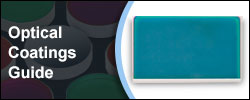

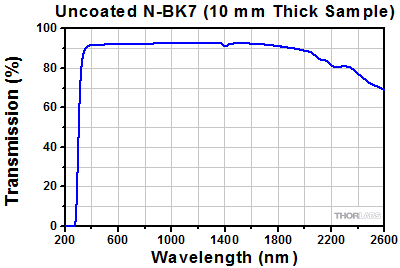

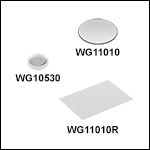
 Zoom
Zoom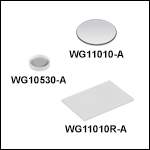



 N-BK7 Windows, 0.35 - 2 µm
N-BK7 Windows, 0.35 - 2 µm